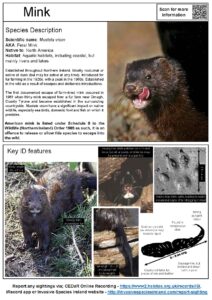American mink
Neogale vison
Overview
Photo credit: © Chuck Homler
American Mink – Neogale vison
Description:
Origin and Worldwide Distribution:
Potential or Known Impacts:
How did it get here?
Is it found in Northern Ireland?
You can help by reporting any sightings: @ the Centre for Environmental Data & Recording (CEDaR) - Or via the iRecord App.
Methods for Prevention:
Further Resources: For further queries, you can contact the Invasive Non Native Species (INNS) Team in the Northern Ireland Environment Agency on 028 9056 9558 or Email: invasivespecies@daera-ni.gov.uk
American Mink – Neogale vison
Description:
- Neogale vison is a medium semi-aquatic carnivore of the weasel family. It has short ears and limbs, and a tail measuring about a third of the body length. They are almost completely dark brown, with white markings in the chin, throat chest and belly. Mink found on fur farms (and their feral descendants) can vary in colour, ranging from white and grey to black.

-
Males are slightly larger than females, with males ranging from 45-65cm and weighing 1100-2000g, and females ranging from 35-55cm and weighting 660-1500g.
- They live in vegetative boundaries of lakes and rivers, along with coasts, wooded marshlands and estuaries. They may live near urban areas provided that sufficient cover and prey are available.
Origin and Worldwide Distribution:
- This species is native to Canada and the United States of America.
- It has been introduced to many other countries as a fur farm animal; it has since escaped or been released into the wild. American mink have been found in South America, Europe (including Ireland and the United Kingdom) and parts of Asia.
Potential or Known Impacts:
- American mink have the ability to predate a large amount of prey items, including waterfowl and fish. They may lead to localised declined in certain species. They are also highly mobile and may travel long distances to find suitable habitats.
How did it get here?
- American mink were introduced as a fur farming animal in many parts of Europe in the 1920s and 1930s. Animals subsequently escaped and the first recorded instance of breeding in the wild was in the late 1950s.
- Mink were brought to Northern Ireland to be commercially farmed for their fur, until that practice was banned in 2003.
Is it found in Northern Ireland?
- They are found throughout Northern Ireland.
You can help by reporting any sightings: @ the Centre for Environmental Data & Recording (CEDaR) - Or via the iRecord App.
Methods for Prevention:
- Do not intentionally release into the wild.
- Report any sightings.
- The Department usually advises that control of mink should only be undertaken if there is evidence that their activities are actually causing problems to a landowner. This may include facilities such as commercial fish or poultry farms.
- When a problem arises, only legal methods of control must be used. When undertaking control measures, special care must be taken to avoid harming any other wildlife species protected under the Wildlife (Northern Ireland) Order 1985
- For further information on control methods see DAERA Standard Operating Procedures for Control of American Mink
American mink research:
| A mink-free GB: perspectives on eradicating American mink Neovison vison from Great Britain and its islands |  |
Further Resources: For further queries, you can contact the Invasive Non Native Species (INNS) Team in the Northern Ireland Environment Agency on 028 9056 9558 or Email: invasivespecies@daera-ni.gov.uk


